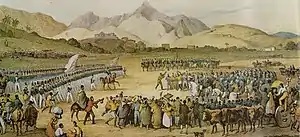Balaiada
The Balaiada was a social revolt between 1838 and 1841 in the interior of the Province of Maranhão, Brazil.
| Balaiada Revolt | |||||||
|---|---|---|---|---|---|---|---|
 Troops departing from Rio de Janeiro to Maranhão, by Rugendas. | |||||||
| |||||||
| Belligerents | |||||||
|
Rebels
| |||||||
| Commanders and leaders | |||||||
| Col. Luís Alves de Lima e Silva |
Cosme Bento † Raimundo Gomes | ||||||
| Strength | |||||||
| 10,000-12,000 | 8,000 | ||||||
| Casualties and losses | |||||||
| 3,000+ killed (between rebels, civilians and military) | |||||||
Background
During the imperial period, the Maranhão region, which exported cotton, suffered a severe economic crisis because of competition with the increasingly-productive United States. In addition, the cattle industry consumed a large part of the workforce in the region. Those factors explain the involvement of the slaves and the poorly-paid free workers in the movement.
A political power dispute arose in the heart of the elite class, which was reflected in Maranhão by the opposition of liberals (bem-te-vis) and conservatives (cabanos). When Pedro de Araújo Lima, Marquis of Olinda became prime minister, provoking the so-called regresso conservador ("conservative regression"), the Maranhão conservatives took advantage of the opportunity to remove the liberals in power and also to weaken them further by contracting the service of the cattle ranchers, traditionally supported by the liberals.
Revolt
The event that began the revolt was the detention of the brother of rancher Raimundo Gomes from the ranch of his father, Inácio Mendes, a contingent of the National Guard, invaded the municipal jail and freed him, in December 1838. Afterward, Gomes, with the support of Cosme Bento, an ex-slave with a force of 3,000 escaped Africans, and Manuel Francisco dos Anjos Ferreira, called the balaio ("basket") because he was a basketmaker, spread the revolt across the interior of Maranhão, conquering the province's second city in importance, Caxias, and going on to Piauí.
Repression
Despite liberals' attempts to control it, the movement acted on its own and got out of control. In the face of a growing mass of people, local elites sought ways to stop the revolt. The imperial government sent troops under the command of Colonel Luís Alves de Lima e Silva and made him the president of the province. By combining political pacification and a military offensive and by offering amnesty to the rebels who aided in the repression, a series of victories led to the successful pacification of the province in 1841.
The leaders of the movement were killed in battle or captured. Many of the captured like Cosme Bento were sentenced and executed by hanging.
Legacy
For his work in the Province of Maranhão, Lima e Silva received the title of Baron de Caxias.
References
- Claudete Maria Miranda Dias. Balaios e Bem-te-vis: a guerrilha sertaneja (2a. ed.). Teresina: Instituto Dom Barreto, 2002.
- Maria de Lourdes Mônaco Janotti. A Balaiada. São Paulo: Brasiliense, 1987.
- Rodrigo Otávio. A Balaiada. Rio de Janeiro: Imprensa Nacional, 1942.
- Rodrigo Otávio. A Balaiada 1839: depoimento de um dos heróis do cerco de Caxias sobre a Revolução dos "Balaios". São Paulo: Siciliano, 2001. ISBN 85-267-0869-4
- Maria Januária Villela Santos. A Balaiada e a insurreição de escravos no Maranhão. São Paulo: Ática, 1983.